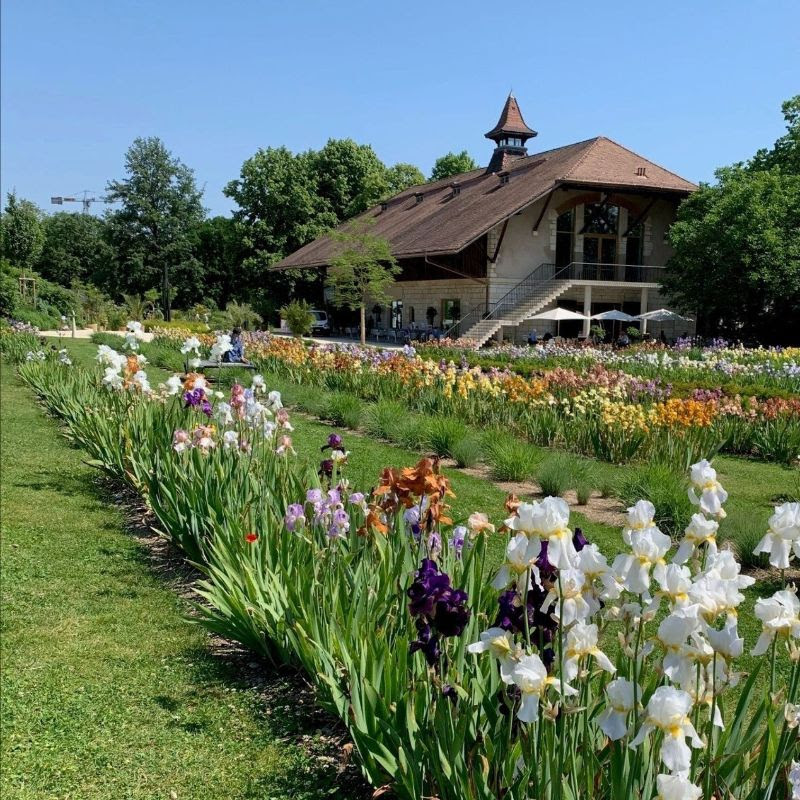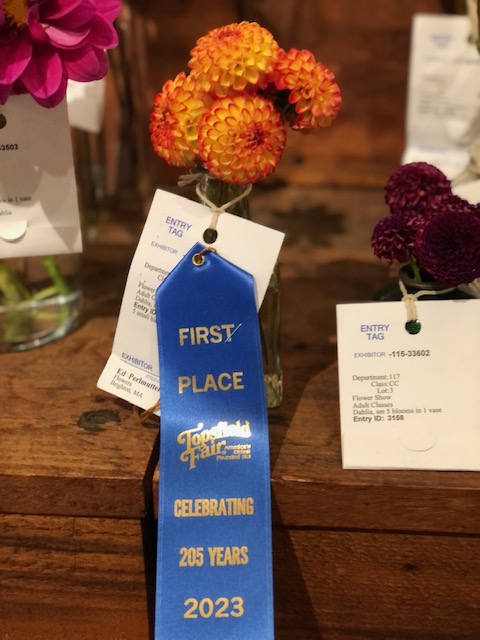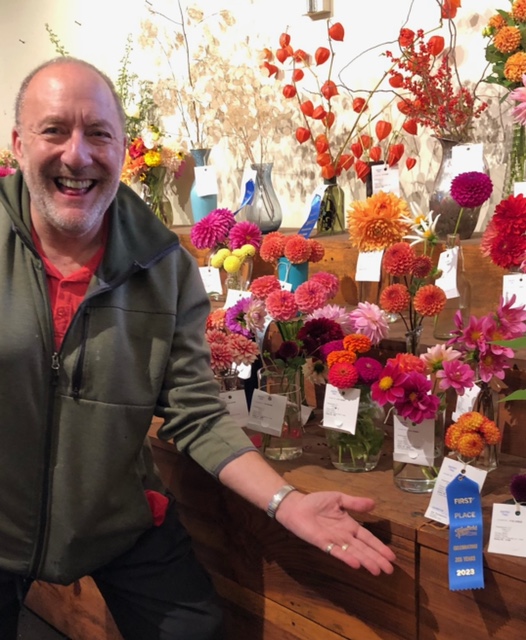To read more by topic or date, see our Newsletter Archives page.
April 14, 2024
“April is a time of wonder, when the spring peepers emerge from hibernation and begin to call, when robins and redwing blackbirds come back north, and when new green life appears. That is one of the greatest of all wonders, the growth of a bud and a leaf from a seed or a root that has lain dormant in the earth all winter.”
– Hal Borland, 1900-1978, American journalist, writer and naturalist.
Spring Shipping Is Full-Speed-Ahead Now

|
We were able to begin shipping iris earlier than normal due to a warm March and our faithful crew of pickers and packers has been working since April 2 on the dahlias, gladiolus, and other orders. We hope to have the rest of the spring orders we have already received on their way to gardeners within the next two weeks and as always we’ll be sending an email notification when a shipment leaves here. We’ll continue taking new spring orders through the end of April, though don’t delay: varieties sell out every day, and some iris will soon be too big to ship (though you’ll have another chance in July.)
OHG Helps HIPS in International Iris Repatriation Exchange

|
Back in the summer of 2021 the Historic Iris Preservation Society sent 26 rare varieties of heirloom iris plants to Merian Gärten of Basel, Switzerland which had disappeared from European gardens over the past century. They hold the largest bearded iris collection open to the public in Europe, preserving around 1500 varieties of tall and medium bearded iris (the type found in most gardens) and close to 100 different wild or species iris. Many of the varieties were developed before the middle of the last century and the Merian Gardens keeps them from disappearing altogether since many are no longer commercially available. We loved the idea of supporting their efforts and contributed ‘Plumeri’ (1888), a fragrant little iris whose jewel-toned colors and early, abundant bloom have made it a long-time favorite of ours. Those, along with donations from other American gardens made up the initial shipment, and since then more varieties have been sent.
HIPS’ Guardian Gardens Network (which distributes heirloom varieties to be preserved in members gardens across the US) put together a wish list of varieties no longer found either in commerce or in American gardens, many of which were developed by American breeders over the past century. Happily, Merian Gardens were able to find many of them in their collection and sent several hundred plants to HIPS last fall! As Lisa Eggenschwiler and Barbara Wüthrich explain, “This is the first time for us to ship plants from our collection outside of Europe. So far, exchanges have been limited to the network with the EU, where the transfer of plant material between scientific institutions is easier. We are happy that we are part of an international network and in this way can contribute to the preservation of iris varieties worldwide with our collection.” The varieties they’ve given have now been distributed among a number of preservation Guardian Gardens across the US so that problems at one won’t mean the loss of all of the variety. It’s good to know there are so many people working to keep these heirloom treasures alive and available to future generations – and thanks to all of our customers who have been doing the same work in their own yards!
“Look Whose Dahlias Took the Blue Ribbon at the Topsfield Fair!”

|

|
We were thrilled last fall to have our good customer Ed Perlmutter write “Wow – was I ever excited when I found a First Place Blue Ribbon slapped on my entry of five small dahlias Friday afternoon at the Topsfield Fair (the oldest agricultural fair in the country). I’m pretty sure it’s Kaiser Wilhelm — the colors are just stupendous*. couldn’t have done it without Old House (and my special sauce fertilizer 😉). It’s been a stunning year. Thank you for all the great years of dahlias (this is my fourth blue ribbon at Topsfield since 2010).”
Congratulations, Ed, thanks for sharing your good news, kind words, and your great photos!
Vanessa and Stephen Orr Talk Hyacinths in March’s issue of Better Homes and Gardens

|
We were delighted to hear from a number of you ordering for the first time last month that you’d found out about us from reading the article “5 Facts About Hyacinths That Will Make You Want to Plant Your Own” – and you weren’t just inspired to order hyacinths, but daffodils, daylilies, dahlias, peonies, and lots more! We especially loved Stephen’s beautiful photographs illustrating the splendid diversity of hyacinth colors, and Vanessa explained why hyacinths have become one of the most commercially-endangered types of bulbs, dropping, as Stephen says, from there being over 2,000 hybrids in the early 1700s to “now you might only find a handful in most catalogs.” We’re so glad to hear that Stephen (who is the editor in chief of BH&G), who’d avoided them for his own garden, tried more than a dozen varieties last year and now delights in their fragrance, spectrum of colors, historic importance and value as a nectar source for pollinators in early spring. We think all of you planting them for the first time this fall will be equally enchanted come next spring!
Tips from Paul Siskind to Deter Scarlet Lily Beetles

|
These shiny red beetles (also known as lily leaf beetles, Liliocerus lilii) is a destructive Eurasian species that has been spreading across New England and the midwest since the 1990s. Both adults and larvae feed on the leaves, stems and flowers of native and hybrid lilies and can completely defoliate a plant if left unchecked. As our lilies break dormancy and send up their tender shoots here in Michigan we realized it’s time to start considering controlling them now. Adult beetles overwinter in the soil or leaf litter, emerge in spring and start laying eggs on iris leaves right away, so early detection is important. Our local extension bulletin has pictures of the adult, eggs and (disgusting) larvae to help you recognize them. Handpicking is a great place to start; the beetles are very sensitive to motion, so it’s helpful to hold a jar of soapy water under the leaf as you reach in to try to catch and crush them. Check your lilies daily early in the season for best control; if you can keep the population at a low level you can check less often in the summer.
If that’s not enough, however, we found Paul Siskind’s article in the North American Lily Society bulletin helpful as he shared his investigations into other relatively ‘natural’ or ‘environmentally friendly’ methods of control. He found that dusting with diatomaceous earth isn’t particularly effective, though it’s also unlikely to harm beneficial insects. Deer or rabbit repellents only had some effectiveness if they contained clove oil. But “if you have a moderate-severe infestation, the ‘safest” and most effective insecticide is spinosad because it kills both the beetles and the larvae. Compared with many other broad-spectrum insecticides, spinosad is safer because it doesn’t get absorbed into the plant and spread systematically into the plant’s fluids or pollen; rather, it remains of the leaf surface, where it kills the beetles/larvae by both contact and via ingestion.” Of course, read and follow all directions on the label, and avoid spraying blossoms or when wind interferes with targeted application onto just the lily leaves.
Along with this, Paul recommends alternating a spinosad spray with neem oil, which, though it only kills larvae, helps to prevent the development resistance to spinosad. The active ingredient in Neem that kills this species’ larvae is azadirachtin which, unfortunately, is removed in neem oils made through alcohol extraction, often found in products labeled as containing “clarified hydrophobic extracts of neem”. Look for “cold-pressed neem oil”, sometimes listed as “pure” neem oil. As far as timing, he says “At the beginning of the season (as soon as the lilies start to sprout), try to spray the lilies twice a week with spinosad. When you start seeing larvae, switch to neem once a week and spinosad once a week. On the days without spraying, do your usual hand-picking of beetles and larvae.” Once the egg-laying season has ended (about 4-6 weeks), you should see a decline in beetles and larvae and be able to cut back to using just spinosad once a week while still hand-picking.
Is it worth it? Native lilies are highly attractive to the beetles, so by reducing them in gardens, we can protect other species in the wild. Daylilies are not affected by these beetles, and both Lilium speciousum rubrum ‘Uchida’ and Lilium ‘Black Beauty’ have been observed to be less attractive to - and less damaged by - the beetles than Asiatic or other Oriental varieties. And lilies are beautiful and often fragrant, so for many, the answer is yes - as Paul says, “It might take a full season (or two) to get a bad infestation under control, but once it’s under control, it’s not difficult to incorporate this method into your normal gardening routine.”
Share Our Gazette with a Friend
Please help us “Save the Bulbs!” by forwarding our newsletter to a kindred spirit, garden, museum, or group.
To Reprint Any Part of Our Gazette . . .
Simply credit www.oldhousegardens.com.











